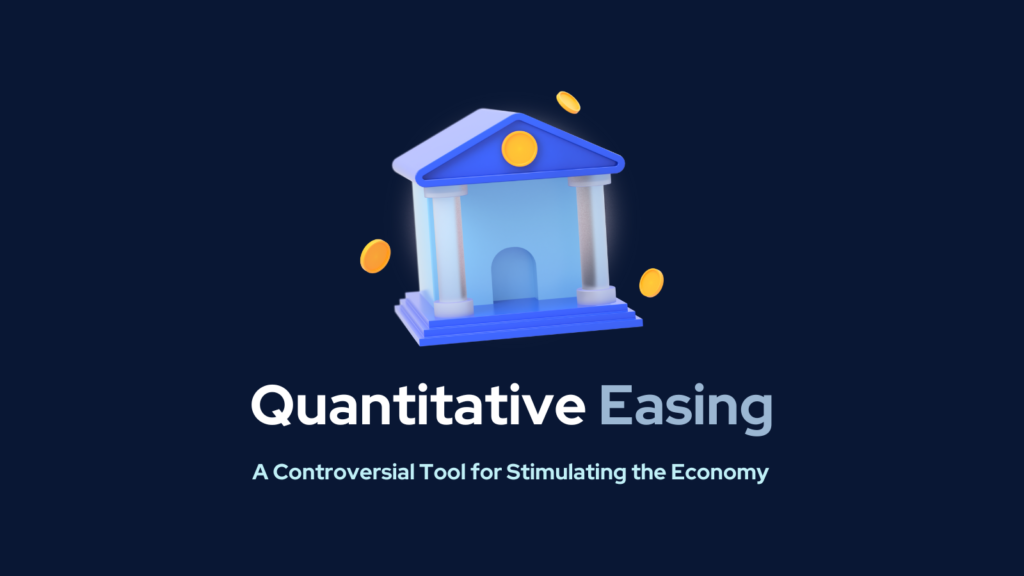

- Understanding Quantitative Easing
- The Roots of QE
- Objectives of Quantitative Easing
- Countries that Utilize QE
- How central bank asset purchases seem to affect markets
- Challenges and Criticisms
- Takeaway

Quantitative easing (QE) is a monetary policy tool used by central banks worldwide to encourage economic development, combat deflation, and also address financial crises. It has been an important policy tool, particularly after the 2008 financial crisis. In addition, we'll look at what QE is, why it was implemented, and which countries have used it.
Understanding Quantitative Easing
QE is a non-traditional monetary policy tool in which central banks create new money in order to purchase financial assets from the private sector, often government bonds or other securities. Consequently, This fresh money is intended to cut interest rates, increase lending, and encourage spending and investment in the broader economy.
The Roots of QE
QE emerged as a response to the global financial crisis of 2008. Traditional monetary policy tools, such as lowering interest rates, proved insufficient to stimulate economic growth and combat deflation. Subsequently, Central banks, including the US Federal Reserve, the European Central Bank (ECB), and the Bank of Japan, resorted to QE as a means to provide additional monetary stimulus.
Objectives of Quantitative Easing
Interest Rate Management:
QE aims to reduce long-term interest rates by central banks purchasing huge quantities of government bonds. As a result, borrowing becomes more affordable for both enterprises and individuals.
Asset Price Support:
QE helps to stabilize financial markets and boost the value of various securities by acquiring assets, which is crucial during times of crisis.
Inflation and Economic Growth:
QE can increase spending, investment, and economic growth while mitigating the danger of deflation.
Countries that Utilize QE
- United States: Following the 2008 financial crisis, the Federal Reserve started numerous rounds of QE, and QE initiatives have become a vital element of its toolset.
- European Union: To fight the eurozone's economic woes, the ECB has also launched its own QE program in 2015.
- Japan: For a long time, the Bank of Japan has been undertaking QE in order to battle deflation and stimulate economic growth.
- United Kingdom: During the financial crisis, the Bank of England used QE and has continued to do so as needed.
- Other countries, such as Switzerland and Sweden, have used QE as a policy instrument.
How central bank asset purchases seem to affect markets
Federal Reserve and S&P 500

The graph depicts the Federal Reserve's assets and the S&P 500 index, with weekly data from 2008 to 2023. The graph demonstrates that the S&P 500 has usually risen since the Fed initiated QE in 2008. There have, however, been instances of volatility, such as the dramatic drop in stock prices in early 2020.
According to the graph, the Fed's asset growth has been beneficial to the S&P 500. However, it is vital to recognize that other factors, such as economic growth, business earnings, and investor sentiment, influence stock prices.
Central Bank Asset Purchases and MSCI World Returns

This graph shows the central banks asset purchases and the MSCI World Index returns over a period of time, Consequently, It suggests that there may be a positive correlation between central bank asset purchases and stock market performance.
Challenges and Criticisms
While QE has been shown to be effective in stabilizing economies and financial markets during crises, it is not without criticism. However, critics believe that QE can contribute to income inequality, asset bubbles, and financial market distortions. Furthermore, it may not always have the desired effect on true economic growth.
Takeaway
Quantitative easing is a one-of-a-kind monetary policy instrument used by central banks to deal with unusual economic conditions. It has also played an important role in encouraging economic development, decreasing interest rates, and stabilizing financial markets. While QE has been an important tool for central banks, its long-term effects are still unknown.
As central banks manage economic issues, QE will remain an important tool in their toolbox, albeit with varied degrees of influence and success based on each country's individual economic conditions and policies.



Drop us your query at – info@pawealth.in or Visit pawealth.in
References: UBS Bloomberg | Yardani Research | BOJ | Federal Reserve
Disclaimer: The report only represents the personal opinions and views of the author. Also, No part of the report should be considered a recommendation for buying/selling any stock. Thus, the report & references mentioned are only for the information of the readers about the industry stated.
Most successful stock advisors in India | Ludhiana Stock Market Tips | Stock Market Experts in Ludhiana | Top stock advisors in India | Best Stock Advisors in Gurugram | Investment Consultants in Ludhiana | Top Stock Brokers in Gurugram | Best stock advisors in India | Ludhiana Stock Advisors SEBI | Stock Consultants in Ludhiana | AMFI registered distributor | Amfi registered mutual fund | Be a mutual fund distributor | Top stock advisors in India | Top stock advisory services in India | Best Stock Advisors in Bangalore



